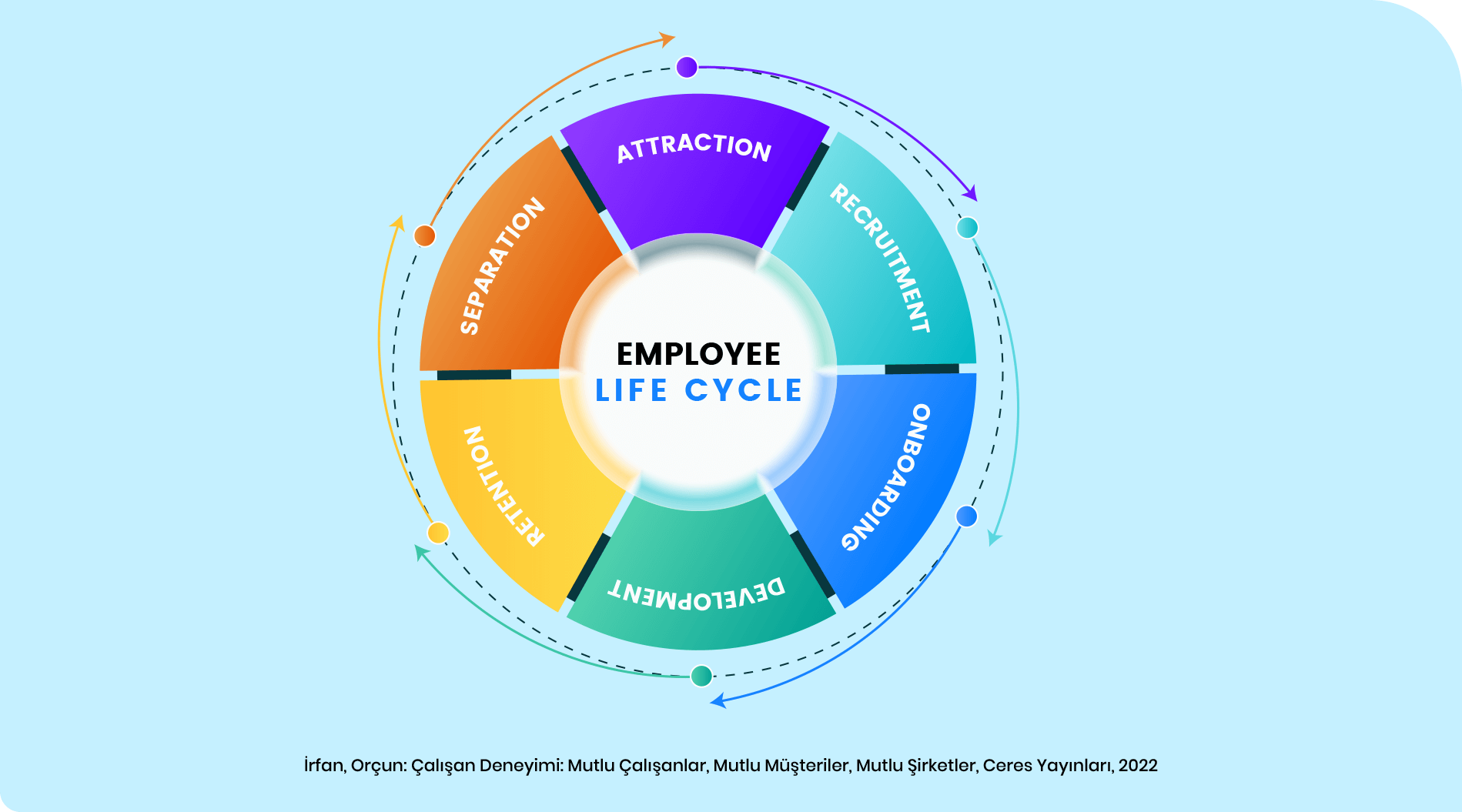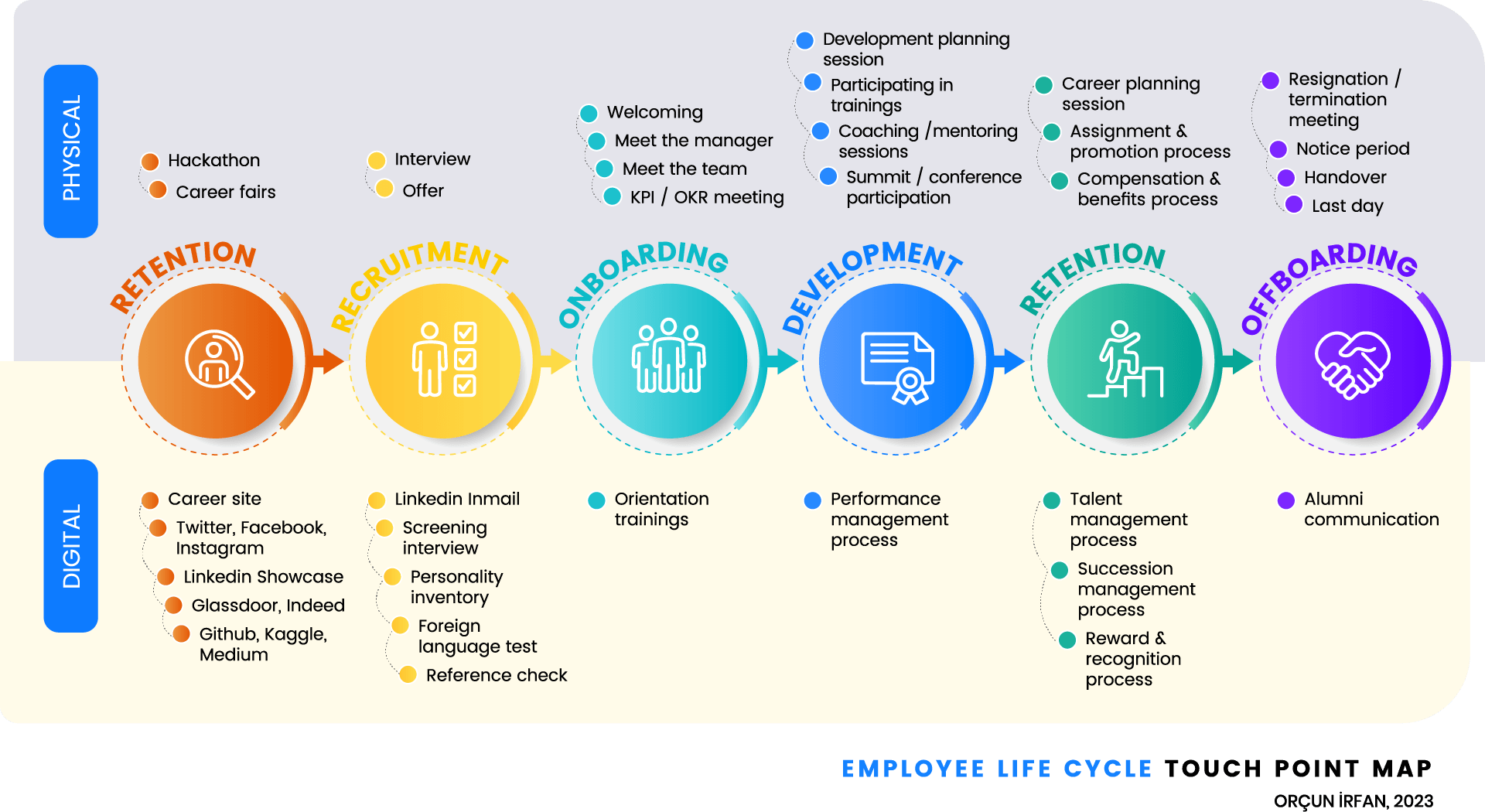We begin employee experience training by defining what it means. Similarly, let’s start this article by Orçun Irfan with a definition.
Employee experience is the overall perception employees form through their interactions with an organization.
Two key elements in this definition—interaction and holistic perception—are crucial components of employee experience.
Now, let’s explore a few essential questions:
How does an employee interact with an employer?
What perception forms from these interactions?
Can companies design these experiences to shape a positive outcome?
These questions open the door to endless possibilities in improving employee experience.
To answer the first question, we must discuss the employee life cycle—a long-standing HR model covered in our past articles.
The Employee Life Cycle that Works as a Rooftop Journey Map
The Employee Life Cycle (ELC) is a journey map that helps employers track and manage each phase of an employee’s career.

Although the model varies between 5 to 7 parts, this article follows the 6-part version from my 2022 book on employee experience.
First, let’s examine each phase to understand the model thoroughly.
Employee Lifecycle: Attraction Phase
The attraction phase is where organizations build employer branding, making their brand visible and appealing to top talent.
At this stage, employers ask, “Why choose us over others?” and support their case with compelling arguments.
Common channels include career fairs, internships, hackathons, social media, and job platforms like LinkedIn, Glassdoor, and Indeed.
Though not yet employees, these candidates are part of the employee life cycle as potential hires.
How candidates interact with organizations during this phase shapes their overall perception.
For example, a career fair booth serves as an interaction point. Its design, staff, and materials influence the candidate’s impression.
Similarly, a corporate website’s career page offers a digital experience. Design, usability, content, and culture expression impact the candidate’s perception.
Employee Lifecycle: Recruitment Phase
During the recruitment phase, organizations assess applicants influenced during the attraction stage. Tools like interviews, assessments, and language tests deepen interactions.
This phase also includes emotional moments, such as receiving an offer or rejection, which often become lasting memories.
While we’ve previously explored this topic, it’s crucial to highlight these impactful moments again.
Moments that Matter in Employee Experience
A Cornell University study by Dr. Thomas Gilovich explains experience formation as: Event → Emotion → Experience → Memory.
A triggering event sparks emotions, shaping experiences that later become memories.
Some intense moments instantly turn into lasting memories with strong emotional impact—these are called Moments of Truth (MoT).
Moment of Truth in Employee Experience
Dr. Thomas Gilovich defines a Moment of Truth (MoT) as when a brand fulfills—or fails to fulfill—its promise, especially in tough situations.
Customer Experience Example:
You buy car insurance, promised towing, a replacement vehicle, and lodging in case of an accident.
Late at night, your tire goes flat on an empty road while your kids sleep in the backseat. You call for roadside assistance, but the insurer says no tow trucks are available for at least an hour.
That’s a Moment of Truth.
Would you trust this company again? Probably not.
Employee Experience Example:
An organization promotes diversity and inclusion. However, while a female employee is on maternity leave, they fill a role she could have been a strong candidate for—with a male colleague before she returns.
These moments either strengthen trust or break it completely.
The moment of truth.
Moments That Matter in Employee Experience
A Moment of Truth (MoT) is intense but rare. However, daily experiences often have the potential to become lasting memories. In today’s work-life blend, organizations must consider how they want to be remembered in these moments.
Defining Moments That Matter (MtM)
These are life-defining events, like a job offer, first day, promotion, childbirth, or losing a loved one. Organizations that acknowledge these moments enhance employee experience and loyalty.
Interaction Points in Recruitment
Recruitment is a critical phase in the Employee Life Cycle. Each interaction shapes the candidate’s perception of the company.
Recruiter Outreach: The tone and approach in emails, calls, and messages influence the first impression.
Interviews: Setup, corporate culture, and recruiter attitude shape candidate experience.
Selection Tools: Personality tests, language assessments, and platforms must be modern and user-friendly.
Follow-Up: Timely responses impact the candidate’s overall perception.
Designing Meaningful Interactions
Some companies personalize recruitment to enhance candidate experience. For example:
A telecom company tracks when candidates approach HQ, prompting recruiters to greet them at the door.
Younger candidates are interviewed in vibrant, digital-first rooms, while senior candidates meet in traditional settings.
Rejected candidates receive a code to donate to a nonprofit, leaving them with a positive brand impression.
Even unsuccessful candidates share positive experiences, strengthening the employer brand. Thoughtful design makes good experiences possible.
Employee Lifecycle: Onboarding Phase
Onboarding is essential for helping new employees quickly adapt to their teams, managers, and corporate culture, ensuring they perform effectively.
This phase is closely linked to recruitment, as employees typically begin onboarding during their probationary period.
Key Interaction Points
The first day of onboarding includes several important activities that shape the employee’s experience, such as:
Meeting the manager and team members
Setting up company equipment and assets
Receiving company vehicles and materials
Participating in orientation training and goal setting
If employees aren’t welcomed, introduced to key team members, or shown around, the first impression will suffer.
Outdated, irrelevant, or disconnected training programs fail to engage employees, leaving them uninspired. This detracts from the onboarding experience.
A negative first day creates a poor holistic perception of the company, affecting future engagement and overall employee satisfaction.
Employee Life Cycle: Development Phase
The development phase, the fourth stage in the employee life cycle, focuses on structured training and development activities that promote both personal and professional growth.
This stage closely follows onboarding and is closely linked to it, just as recruitment is tied to onboarding.
Key Development Activities
At this phase, employees engage in:
Training sessions
Coaching and mentoring
One-on-one feedback meetings with managers
The performance management process (if aimed at development)
These moments of interaction shape the employee experience.
Impact of Missing Development Practices
When an organization lacks these practices, it sends a clear message about its culture. The absence of development activities speaks volumes, offering a negative experience to employees.
The End Result of the Development Phase
By the end of this phase, employees should feel valued and supported. They might think, “I’m glad I work here; they invest in my growth,” or, “Nobody cares for me here; I feel unsupported.”
The experience and perception at the end of this phase can be carefully structured and planned in advance.
Employee Life Cycle: Retention Phase
Retention phase is the pinnacle objective that all phases of the employee life cycle want to achieve. To keep the efficient, productive, happy and engaged employee within the organization.
In this sense, it works very synergistically with the development phase of the employee life cycle.
Talent management meetings, career management plans, promotion & assignment processes, succession maps, salary and benefit increase communications are all important interaction moments during the retention phase.
The design quality and execution effectiveness of these moments directly affects how the experience of the employee will be shaped.
While well-thought-out layouts that are designed according to the user’s needs create the following feeling in the employee:
“There is a good future for me here! I can develop my career here and I can easily see my future. I am improving and getting the reward of my hard work!”
Poorly designed processes or having not designed in put into practice anything at all can easily create the following perception in the employee:
“What am I doing here? I don’t get paid for my work. And no matter how hard I try I can’t get anywhere. Best to start looking for a job.”
Due to the nature of the activities it contains, the effect of this phase spreads over a period of time that goes beyond a calendar year and the experience and holistic perception created in this phase may cause the employee to either become an engaged one or a quite quitter who wants to leave the organization as soon as possible.
Employee Life Cycle: Offboarding Phase:
Offboarding phase is the last stage of the employee life cycle and constitutes all of the activities necessary for the employees who have parted ways with the organization to leave the company in a smooth and healthy process with positive impressions about the organization.
Resignation/termination of employment interview, notice period, handover, last working day, exit interview and even communication with alumni communities are all important moments of interaction in this phase.
Employees who leave the organizations will naturally tell their spouses, friends and acquaintances about their experiences and memories of their former employers and will give positive or negative opinions to those they know who will go to job interviews with their former companies. Therefore, depending on the holistic perception they have about their former companies, they will either turn into cultural ambassadors who will make a positive impact on the employer brand of the organization or become culture activists and will work against the employer brand.
In this sense, thanks to the synergy it creates with the attraction phase, offboarding phase combines the employee life cycle literally as a cycle.
Touch Points in Employee Experience
We talked about the interaction points throughout the article. Before concluding our article let’s name them properly as touch points in employee experience.
If we are able to provide the user with an experience in line with the designed plan, the touch point in question turns into a gain point for us.
If the experience at the mentioned touch point is flowing against the designed plan, this time it turns into a pain point for the user.
As experience designers, our job is to follow the flowing experience, if possible in real-time, at all these touch points and turn possible pain points to gain points with timely interventions when necessary.
Perhaps it may be possible to follow these touch points in small companies with low employee numbers and where everyone works in the same physical environment with the naked eye or with simple applications such as Excel and Google Sheets.
However, it is not possible to measure and follow the instantaneous experience with the naked eye and with individual effort in companies with a high number of employees especially where working environments are spread over different geographies and even time zone and on top of that, operating in the hybrid model.
Usage of Touch Point Maps in Employee Experience
A touch point map is a tool used frequently in the customer experience. It is very useful in terms of drawing the big picture by revealing in which channels and in what ways the customer interacts with the brand.
The touch point map, like the journey map, is a tool that can be made in different ways and can be interpreted according to needs. If you so desire you can set up the entire map in a way to define only the touch points related to the users in a certain service design or to show all the touch points you provide during an entire journey with the physical and digital channel separation.
You can find a sample touch point map of the employee life cycle that we discussed in this article as follows.
This map depicts the touch points where employees interact with their employer throughout their careers divided into segments in physical and digital channels.

But how do we measure, track and manage the experience flowing through all these touchpoints?
Touch Point Management and HR Analytics
At this point, HR Analytics, another important companion of employee experience, comes into play. In our next article, we will take a closer look at the discipline of analytics, where employee experience collaborates to generate value from data and the amazing synergy between employee experience and HR Analytics.
How TEG EX Can Help You
As I always say, employee experience is a data-driven discipline. The way to unlock the full potential of the employee experience is to first get the voice of the employee (VoE) through as many channels as possible and in a way that makes things easier for the employee then to refine this voice and make it understandable and actionable for all relevant stakeholders.
Thanks to its design developed together with HR professionals, TEG EX enables 20 critical touch points and 3 moments that matter over 5 phases of the employee life cycle from recruitment to separation with pre-prepared questionnaires specific to the target audience. Moreover, it reports these metrics on real-time streaming data and with an industry-first employee lifecycle score (ELC Score).
For more information about TEG EX, you can contact TEG right now.
If you are interested in the employee experience, a young data-based discipline with a huge potential still waiting to be discovered see you in our next article!

